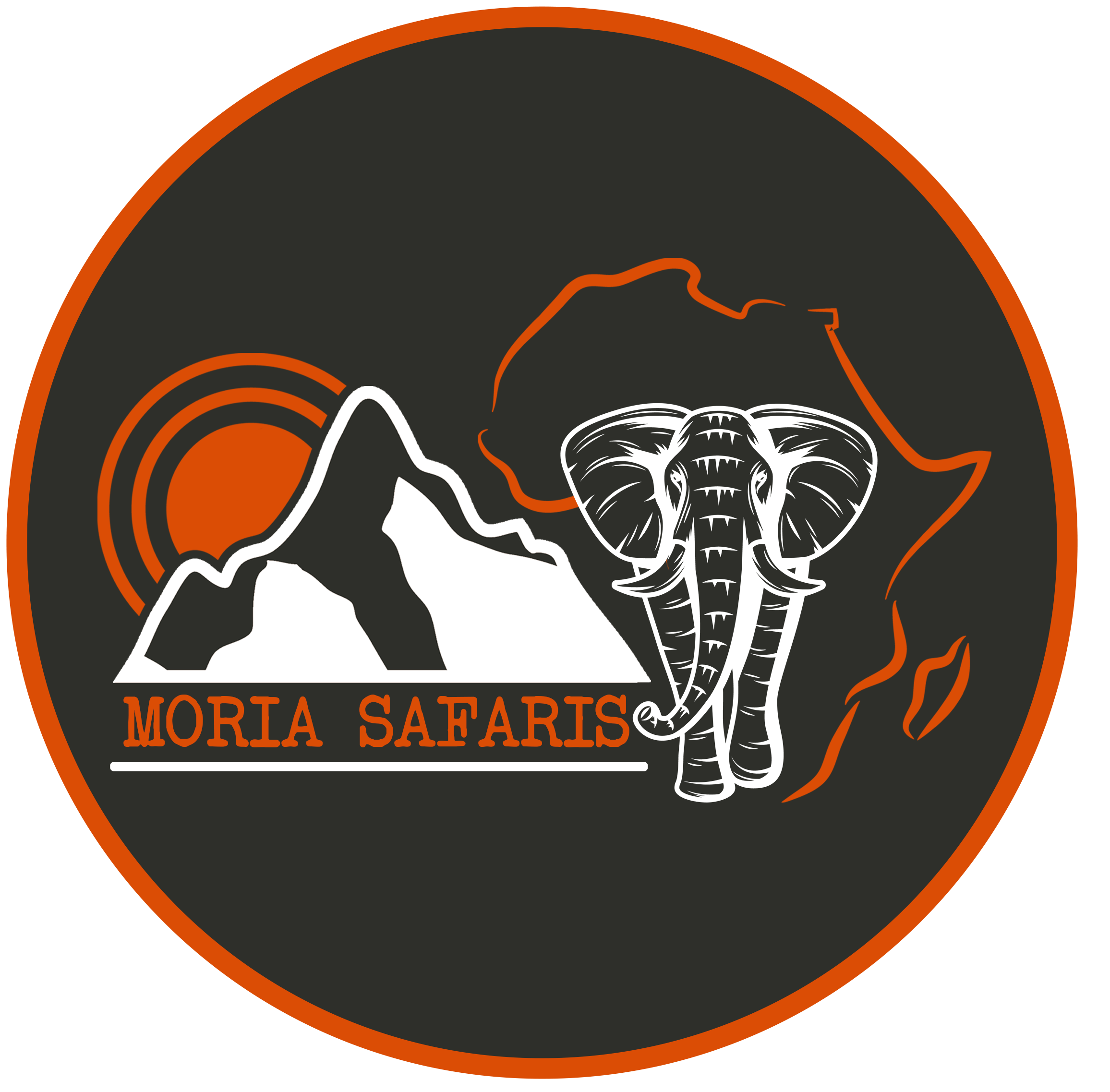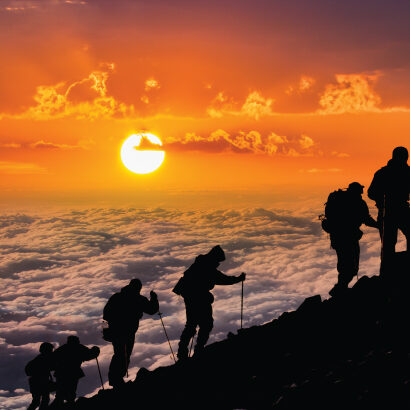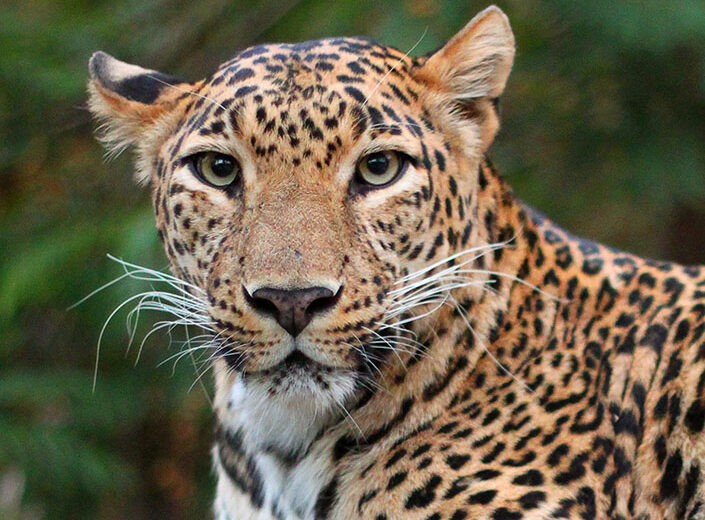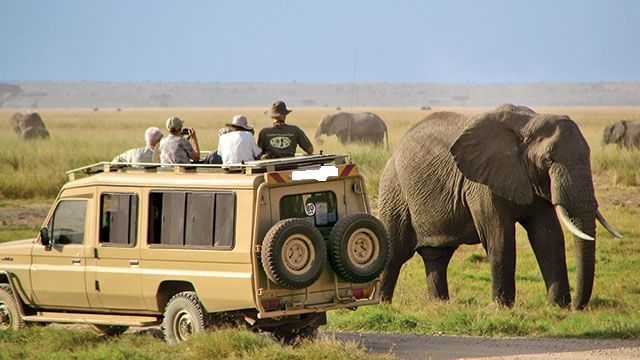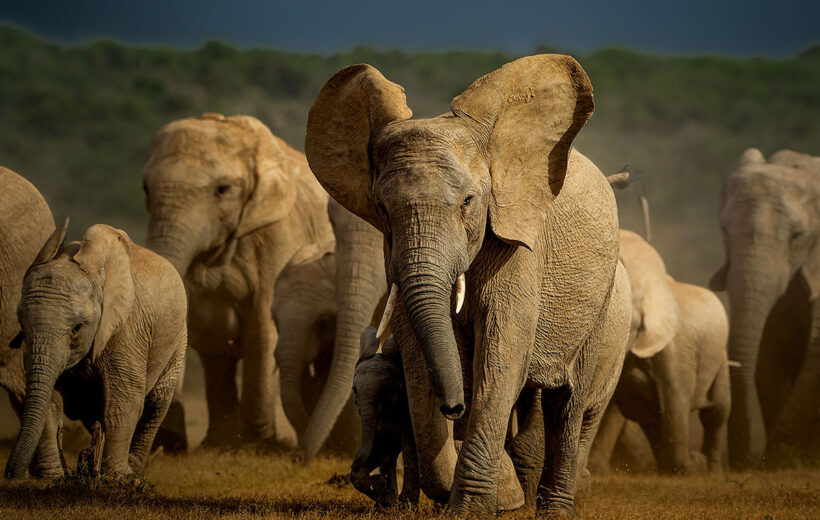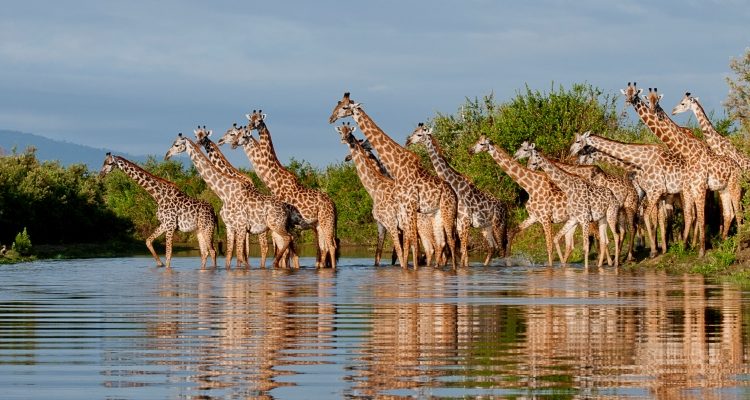Nyerere National Park-Tanzania
Nyerere National Park
Selous Game Reserve, now known as Nyerere National Park, is one of the largest and oldest protected areas in Africa. It’s located in southern Tanzania and covers an enormous area of around 54,600 square kilometers (21,081 square miles). This immense wilderness is home to a remarkable diversity of wildlife and offers visitors a chance to experience a pristine and less-touristy African safari. Here are some key points about Selous National Park:
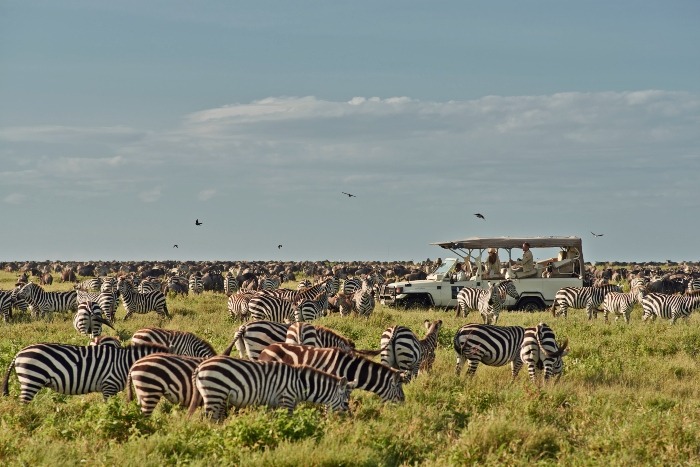
Key features of Nyerere National Park
Abundance of Wildlife: Selous is known for its rich biodiversity, including large populations of elephants, buffaloes, hippos, crocodiles, wild dogs, and various antelope species. The park also hosts a wide array of bird species, making it a paradise for birdwatchers.
-
- Landscape Variety: The park’s landscapes vary from open grassy plains to dense thickets, miombo woodlands, and meandering rivers. The Rufiji River, which runs through the park, is home to numerous hippos and crocodiles and is a vital water source for many animals.
- Wild Dog Population: Selous is renowned for its significant African wild dog population, one of the largest in the world. These endangered predators are a rare sight in many other African parks.
- Boat Safaris: One of the unique aspects of Selous is its river and boat safaris. Tourists can explore the park’s diverse ecosystem and observe wildlife from the water, offering a fresh perspective on the animals and landscapes.
- Walking Safaris: In addition to traditional game drives, Selous offers guided walking safaris, providing a more intimate and close-to-nature experience.
- Cultural Encounters: The region surrounding Selous is inhabited by local tribes such as the Maasai, and there are opportunities to visit their villages and experience their culture.
- Scenic Beauty: The park is not just about wildlife; it also boasts breathtaking scenery, including rolling hills, cliffs, and the spectacular Stiegler’s Gorge along the Rufiji River.
- Off the Beaten Path: Selous National Park is a less-visited safari destination, offering a quieter and more exclusive experience compared to more popular parks like Serengeti or Ngorongoro.
- Conservation: The park is part of a UNESCO World Heritage Site and plays a crucial role in the conservation of African wildlife and ecosystems. Efforts are made to protect its pristine wilderness.
Best Time to Visit
- Overview
- What To Do
- Dry Season
- Birdwatching
- Cultural Experiences
- Avoiding Crowds
- Accommodation
- How To Get There
The best time to visit Nyerere National Park, formerly known as Selous Game Reserve, in Tanzania depends on your preferences and what you hope to experience during your safari. Nyerere National Park offers unique attractions year-round, but the optimal time may vary based on various factors. Here are the primary considerations for the best time to visit Nyerere National Park:
1. Dry Season (June to October):
- June to October: This is generally considered the best time to visit Nyerere National Park. During the dry season, the weather is pleasant, and the vegetation is less dense, allowing for excellent wildlife viewing. Animals congregate around water sources, making it easier to spot them.
- September and October, in particular, are fantastic months as water sources dwindle, and wildlife is concentrated around the remaining waterholes.
2. Shoulder Season (November to March):
- The period from November to March is still a good time to visit Nyerere National Park. During these months, the park transforms into a lush green paradise as the rainy season begins. The landscape is teeming with life, and it’s an excellent time for birdwatching.
- However, the rain can make certain roads impassable, and wildlife is more dispersed, so patience may be required.
3. Birdwatching Season:
- If you are a bird enthusiast, the wet season (November to March) is ideal. Nyerere National Park is renowned for its diverse birdlife, and this is when migratory species arrive.
4. Fewer Crowds:
- The park is less crowded during the rainy season. If you prefer a quieter and more exclusive safari experience, visiting during this time can be advantageous.
5. Boat Safaris:
- From June to November, when water levels are lower, boat safaris along the Rufiji River are at their best. This offers a unique perspective on the park’s wildlife, including crocodiles and hippos.
6. Excellent Photography:
- Both the dry and wet seasons offer unique photography opportunities. The dry season’s landscapes are picturesque, while the wet season provides vibrant green backgrounds for wildlife shots.
7. Wild Dog Sightings:
- Nyerere National Park is known for its African wild dog population. For the best chances of spotting these endangered predators, the dry season is ideal, as they become more active when hunting.
Ultimately, the best time to visit Nyerere National Park depends on your interests and priorities. Each season has its own charm and offers distinct advantages, whether it’s the dry season for concentrated wildlife, the wet season for lush landscapes, or the birdwatching opportunities throughout the year. Plan your visit according to your specific preferences for wildlife viewing and weather conditions.
Nyerere National Park, formerly known as Selous Game Reserve, is the largest protected wildlife area in Africa, offering a wide range of activities for nature and safari enthusiasts. Here are some of the things you can do in Nyerere National Park:
-
Game Drives:
- Embark on thrilling game drives to explore the park’s diverse ecosystems and wildlife. Nyerere National Park is known for its abundant wildlife, including elephants, lions, leopards, buffaloes, giraffes, hippos, crocodiles, and a variety of antelope species.
-
Boat Safaris:
- Explore the Rufiji River, which winds through the park, on a boat safari. This provides a unique perspective on the park’s wildlife, including hippos, crocodiles, and a wide range of waterfowl.
-
Walking Safaris:
- Experience the park on foot with guided walking safaris. This allows you to connect more intimately with the flora and fauna and learn about the smaller aspects of the ecosystem, from insects to birdlife.
-
Fly Camping:
- For a more adventurous experience, try fly camping, which involves setting up temporary camps in the wilderness. It’s a unique way to immerse yourself in the sights and sounds of the African bush.
-
Birdwatching:
- Nyerere National Park is a paradise for birdwatchers. The park is home to hundreds of bird species, including herons, storks, eagles, and kingfishers. The wetlands and riverine habitats provide exceptional birdwatching opportunities.
-
Photography:
- Capture the park’s breathtaking landscapes and remarkable wildlife through photography. The dramatic light and varied settings in Nyerere make it an excellent destination for photographers.
-
Visit Stiegler’s Gorge:
- Explore Stiegler’s Gorge, a striking geological feature within the park. The gorge is a picturesque spot for nature enthusiasts and photographers.
-
Fishing:
- Enjoy fishing along the Rufiji River or within the park’s lakes. Catch and release fishing is common in the area, and you can target species like catfish and tigerfish.
-
Cultural Tours:
- Learn about the local cultures in the surrounding areas. Visit nearby communities and interact with the indigenous people to gain insights into their traditions, customs, and way of life.
-
Conservation Experiences:
- Participate in conservation-focused activities to learn about the efforts to protect the park’s wildlife and ecosystems. Some lodges and organizations offer educational programs and initiatives.
-
Scenic Flights:
- Take to the skies on a scenic flight over Nyerere National Park. Aerial tours provide breathtaking views of the park’s vast landscapes and the Rufiji River.
-
Relax and Unwind:
- Some lodges within the park offer leisurely activities like lounging by the pool, enjoying sundowners, or indulging in spa treatments for relaxation.
Remember that guided activities are a fundamental aspect of experiencing Nyerere National Park. Engage the services of experienced guides to ensure your safety and enhance your understanding of the park’s natural wonders. Whether you’re interested in big game safaris, birdwatching, or cultural experiences, Nyerere National Park offers a wide range of activities to suit your interests and provide a memorable adventure in the heart of Africa.
For optimal game viewing, consider visiting during the dry season from late June to October. The animals congregate around water sources, making them easier to spot.
- For the best game viewing and wildlife sightings, consider visiting during the dry season, which typically runs from late June to October. During this time, the vegetation is less dense, and animals congregate around water sources, making them easier to spot.
- The dry season is also when predators are particularly active, as they take advantage of the concentrated prey.
-
Nyerere National Park is a paradise for birdwatchers, offering an incredible diversity of avian species in its varied ecosystems. With a wide range of habitats, from wetlands and riverine forests to grasslands and woodlands, this vast park provides excellent opportunities for birdwatching. Here’s what you need to know about birdwatching in Nyerere National Park:
Rich Birdlife: Nyerere National Park is home to over 440 bird species, making it a haven for both seasoned and novice birdwatchers. The park’s wide array of habitats sustains numerous waterfowl, raptors, songbirds, and other unique species.
Birding Hotspots:
- Rufiji River: The Rufiji River, which meanders through the park, is a birdwatcher’s dream. It’s a habitat for numerous water-associated species, including African fish eagles, kingfishers, herons, and storks.
- Lakes and Pools: The park’s lakes and pools attract various water birds, including flamingos, pelicans, and spoonbills.
- Riverine Forests: These lush areas are home to a variety of bird species, such as the white-fronted bee-eater, the African paradise flycatcher, and the purple crested turaco.
- Woodlands and Grasslands: These habitats are inhabited by birds like the lilac-breasted roller, yellow-collared lovebird, and the Fischer’s lovebird.
- Miombo Woodlands: The park’s miombo woodlands are home to species like the green-capped eremomela and the Pale-billed hornbill.
A Birdwatching Guide:
- Hiring an experienced birdwatching guide can greatly enhance your experience. They are knowledgeable about the park’s bird species and their habits, which can help you spot and identify birds more effectively.
Birding Excursions:
- Guided birding excursions are available through various lodges and tour operators in the park. These excursions can be tailored to your preferences, whether you’re interested in waterfowl, raptors, or forest-dwelling species.
Best Time for Birdwatching:
- Birdwatching in Nyerere National Park is rewarding year-round. The wet season (November to March) is excellent for migratory species, while the dry season (June to October) offers clear views of resident birds.
Bring Binoculars and Field Guides:
- Don’t forget to pack a pair of good binoculars and a field guide to East African birds to help with bird identification. A spotting scope can also be useful for observing birds in the distance.
Patience and Quiet Observation:
- Birds can be elusive, so patience and quiet observation are key. Spend time in one spot and listen for calls and songs, which can lead you to hidden gems.
Birdwatching in Nyerere National Park provides a wonderful opportunity to discover the diverse avian life of Tanzania. Whether you’re an avid birder or a casual observer, the park’s rich birdlife and stunning landscapes make it a remarkable destination for birdwatching in Africa.
Cultural experiences in Nyerere National Park, formerly known as Selous Game Reserve, offer a unique and enriching dimension to your safari adventure. While the primary draw of the park is its diverse wildlife and pristine landscapes, you can also engage with the local communities and learn about their traditional cultures. Here’s what you can expect in terms of cultural experiences in Nyerere National Park:
-
Visit Local Villages:
- Nyerere National Park shares its boundaries with several local villages. Guided visits to these communities allow you to interact with the indigenous people, such as the Rufiji and Matambwe communities. You can learn about their traditional lifestyles, customs, and daily routines.
-
Cultural Tours:
- Many lodges and tour operators offer cultural tours that include visits to local communities. These tours provide insights into the customs and traditions of the indigenous people, including their housing, clothing, and food preparation.
-
Traditional Dances and Music:
- Cultural performances, including traditional dances and music, are often a part of cultural tours. Local community members may showcase their vibrant dances and music, offering a delightful and authentic experience.
-
Craft Demonstrations:
- Local artisans often demonstrate their craft skills, including beadwork and woodcarving. You can watch them create intricate jewelry and traditional artworks and even purchase their handmade products.
-
Cultural Interactions:
- Engage in conversations with the community members and ask questions about their way of life, challenges they face, and the role of conservation in their communities. These interactions provide valuable insights into their perspectives and livelihoods.
-
Participate in Daily Activities:
- Some cultural experiences may allow you to participate in daily activities such as farming, fishing, or cooking. This hands-on approach can deepen your understanding of the local culture.
-
Cultural Initiatives and Projects:
- Some lodges and organizations within the park actively support and engage in cultural initiatives and community projects. These initiatives aim to promote sustainable tourism, local empowerment, and wildlife conservation. By visiting and supporting such lodges, you can contribute to these efforts.
-
Responsible Tourism:
- Cultural experiences in Nyerere National Park often emphasize responsible tourism practices. This includes respecting local customs and traditions, seeking permission before taking photographs, and purchasing handicrafts directly from the artisans.
These cultural experiences allow you to connect with the people who call the areas surrounding Nyerere National Park their home. By engaging with the local communities and learning about their cultures, you gain a deeper appreciation of the relationship between the people and the environment, as well as the efforts to promote sustainable coexistence between traditional ways of life and wildlife conservation in this remarkable part of Tanzania.
Avoiding crowds in Nyerere National Park can enhance your safari experience and provide a more intimate connection with the park’s natural beauty and wildlife. Here are some strategies to minimize crowds while visiting Nyerere National Park:
-
Choose the Right Time to Visit:
- The peak tourist seasons in Nyerere National Park are from June to October and from December to February. To avoid crowds, consider visiting during the shoulder seasons, particularly November and March to May. The park is generally less crowded during these months.
-
Weekdays Over Weekends:
- Plan your visit during weekdays rather than weekends. Weekends tend to attract more local and international tourists, so visiting on weekdays can offer a quieter experience.
-
Private Safaris:
- Consider booking a private safari or tour. While this option may be more expensive, it provides a more personalized experience and the flexibility to tailor your itinerary to your preferences.
-
Guided Bushwalks and Night Safaris:
- Guided bushwalks and night safaris are often less crowded than traditional game drives. These activities allow you to explore the park’s flora and fauna at a more relaxed pace.
-
Choose Less Popular Camps and Lodges:
- Select accommodations that are not as well-known or are situated outside the main areas of the park. Some lodges and camps within the park can be more crowded, so staying in more secluded options can provide a quieter experience.
-
Camp in Less Visited Areas:
- Nyerere National Park offers designated campsites. Camping in less-visited areas of the park can provide a more secluded experience. Ensure you follow park regulations and guidelines for camping.
-
Respect Quiet Zones:
- Some areas in the park are designated as quiet zones to minimize human impact on wildlife. Adhering to these regulations not only supports conservation efforts but also contributes to a quieter and more peaceful environment.
-
Extended Stay:
- If your schedule allows, consider spending more time in Nyerere National Park. Longer stays allow you to explore the park at your own pace and avoid the rush of one-day visitors.
By following these tips and planning your visit thoughtfully, you can enjoy a more serene and exclusive experience in Nyerere National Park. This enables you to fully appreciate its natural wonders, abundant wildlife, and pristine landscapes without the distractions of larger crowds.
Nyerere National Park, formerly known as Selous Game Reserve, offers a variety of accommodation options that cater to different preferences and budgets. From luxury lodges and tented camps to more budget-friendly options, there’s something to suit every traveler. Here’s an overview of the types of accommodations you can find in and around Nyerere National Park:
1. Safari Lodges:
- Nyerere National Park features a selection of safari lodges that offer comfortable and well-appointed rooms, often with en-suite facilities. These lodges typically provide excellent dining options, lounges, and outdoor areas to soak in the wilderness views. Examples include Sand Rivers Selous and Selous Serena Camp.
2. Tented Camps:
- Tented camps provide a unique and authentic safari experience. They offer spacious canvas tents with modern amenities and en-suite bathrooms. Many tented camps are strategically located in pristine areas of the park, providing a more intimate connection with nature. Options include Selous Impala Camp and Siwandu.
3. Luxury Lodges:
- For visitors seeking the pinnacle of luxury, Nyerere National Park offers high-end lodges that provide top-notch services, gourmet dining, and exquisite accommodations. These lodges often offer exclusive experiences and amenities. Examples include Azura Selous and Roho ya Selous.
4. Permanent Tented Camps:
- Permanent tented camps offer a balance between comfort and immersion in the wild. These camps provide spacious tents with en-suite facilities and often boast an intimate setting. Examples include Sand River Selous and Beho Beho.
5. Campsites:
- Nyerere National Park provides designated campsites for those who prefer a more rugged and adventurous camping experience. Visitors need to bring their own camping equipment, and it’s essential to adhere to the park’s camping regulations.
6. Cultural and Eco-Lodges:
- Some lodges in and around Nyerere National Park focus on sustainable and eco-friendly practices. These lodges often incorporate cultural interactions and immersive experiences, allowing guests to connect with local communities and learn about their traditions.
7. Accommodations Outside the Park:
- Visitors can also choose to stay in lodges and camps situated just outside the park’s boundaries. These accommodations are often more budget-friendly and offer easy access to the park for day trips and safaris.
8. Fly Camping:
- For a more adventurous experience, consider fly camping, which involves setting up temporary camps in the wilderness. It’s a unique way to immerse yourself in the sights and sounds of the African bush.
Nyerere National Park’s accommodations cater to a wide range of travelers, from luxury seekers to those looking for a more rustic experience. Regardless of your choice, you’ll find that these accommodations are well-equipped to ensure your comfort and safety, allowing you to enjoy the pristine wilderness and diverse wildlife of this remarkable park.
HOW TO GET THERE
Selous Game Reserve is one of the largest and most renowned protected areas in Tanzania, located in the southern part of the country. Getting to Selous involves a combination of road and air travel. Here’s how to get to Selous National Park:
By Air:
- Fly to Julius Nyerere International Airport (DAR): Your journey to Selous typically begins with an international flight to Julius Nyerere International Airport (DAR) in Dar es Salaam, which is Tanzania’s largest and busiest airport.
- Domestic Flight to Selous: From Dar es Salaam, you can take a domestic flight to an airstrip near Selous Game Reserve. The most commonly used airstrip is Stiegler’s Airstrip, but there are other options. Several domestic airlines, including Coastal Aviation, Auric Air, and Safari Air Link, operate flights to Selous from Dar es Salaam and other major Tanzanian cities.
By Road:
- Drive from Dar es Salaam: If you prefer a more adventurous journey, you can choose to drive from Dar es Salaam to Selous Game Reserve. The drive typically takes about 6–8 hours, depending on road conditions and the specific camp or lodge you are visiting. The park’s northern gate at Matambwe offers the most accessible entry point from Dar es Salaam. Be prepared for a long but scenic drive, and make sure your vehicle is suitable for the terrain.
- Guided Safari Transfer: Many tour operators and lodges in Dar es Salaam can arrange guided road transfers to Selous. They provide comfortable vehicles, experienced drivers, and the option to break up the journey with sightseeing stops along the way.
Once you arrive at your chosen airstrip or the park’s main gate, your accommodations will typically provide transfers from the airstrip or gate to their camp or lodge.
It’s essential to confirm all travel arrangements with your tour operator or accommodations in advance, as Selous Game Reserve is vast, and road conditions can vary. Also, ensure you have all necessary permits and park entry fees for your visit. Whether you choose to fly or drive, Selous National Park offers an incredible safari experience with its diverse landscapes and abundant wildlife.
